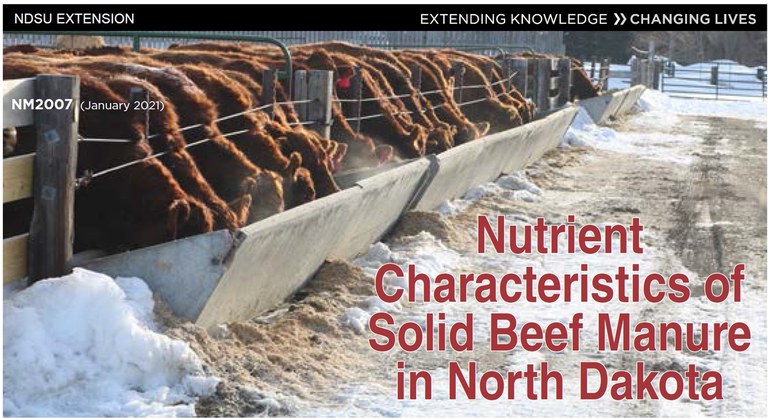Center Points
Livestock Nutrient Management Important on Small Farms
Whether small farms have cattle, horses, sheep or goats, having a plan for spring grazing and manure management is important, especially during dry years.
Monitoring grazing readiness ensures that grazing starts at the proper time. Many times, we are tempted to turn animals out at the first sign of green in the pasture. Grazing too early can limit forage production for the rest of the grazing season and hurt plant health for years to come.
It is recommended that grazing readiness be based on the developmental stage of the most common or key grass species in the pasture. The recommended plant development stage to begin grazing for most tame grass pasture is at the three-leaf stage. This means that three full leaves have emerged from the main stem of the plant.
Knowing the dominant grass species in the pastures is helpful to determine which pasture to graze first in the spring. Cool-season, tame grasses typically start growing first in North Dakota and can handle heavier animal grazing earlier in the season.
Rotating animals to fresh paddocks not only allows for management of a farm’s grazing resources, but it also can help lessen nutrient overload from manure and reduce parasite pressure.
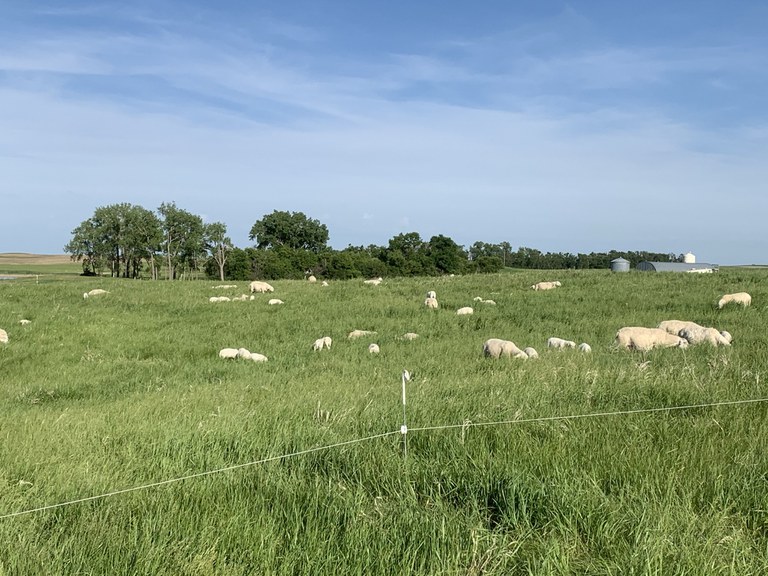 Sheep grazing in a pasture in central North Dakota are frequently rotated to fresh grass to help manage parasite load.
Sheep grazing in a pasture in central North Dakota are frequently rotated to fresh grass to help manage parasite load.
Parasites move in a continuous life cycle. Eggs are deposited in manure and through time, those eggs turn into infective larvae. The infected animals are moved to pasture, where they deposit infected manure, and the parasite is ingested and the cycle starts anew.
Parasites need cool and moist conditions to thrive. Eggs can hatch in as little as six days and larvae can last as long as 120 days. Egg development does not occur when temperatures are at or below freezing and eggs and larvae are killed when temperatures are hot and dry.
Most larvae will be found within the first 2 inches of plant growth from the base of the plant, so managing to ensure overgrazing does not occur will help decrease ingestion of parasites.
Unfortunately, parasites can go dormant inside the host animal during unfavorable conditions, so while you may not think parasites are an issue during a drought, any change to favorable conditions can result in a rapid flush and quick development from egg to infective larvae.
If rotation of animals from pasture to pasture isn’t possible, removing manure daily or weekly from the grazing area is another management strategy. Another method for breaking the parasite life cycle is to use multispecies grazing.
Parasites are host-species specific, so if an infestation occurs in sheep or goats, horses or cattle could rotate into that pasture and not be affected by those parasites. Different species also typically eat and select for different plants, which can help extend the forage supply.
For those who are experiencing small-farm challenges or would like additional tips and information, contact your local county NDSU Extension agent (https://www.ag.ndsu.edu/extension/directory/counties) for resources and help to keep land healthy and productive.
A special thank you to Penny Nester, Ag and Natural Resources agent in Kidder County for being a co-writer on this article.
Mary Keena
Mary.Keena@ndsu.edu
Extension Specialist/ Livestock Environmental Management
Stewardship is for Everyone
Stewardship Week was celebrated last week. Did you miss it?
Sponsored by the NACD (National Association of Conservation Districts – which includes your local SCD) every year between the last Sunday in April and the first Sunday in May, Stewardship Week reminds us of our individual responsibilities to care for the natural resources upon which we all depend.
In North Dakota, those natural resources include the fertile soils that support and enable crops to grow and gardens to flourish, and the clean water that nourishes those plants. We are blessed with clean air. And, we enjoy the native vegetation, including trees. Forests. Forests? In North Dakota?
The theme for this year’s Stewardship Week is “Healthy Forests, Healthy Communities”. In our prairie state, we have native State Forests in the Turtle Mountains, the Pembina Gorge, and the Sheyenne River Valley. Native riparian & upland forests blanket the banks of our rivers. The 50,000 miles of shelterbelts or windbreaks stretched across the state are sometimes referred to, tongue-in-cheek, as linear forests. And then, we have community forests – those trees that beautify family homes, shade the streets and grace the parks of more than 350 communities in North Dakota, covering about 400,000 acres.
Trees help stabilize our soils, slow rainwater runoff (filtering the water in the process), and clean the air by removing particulate matter & absorbing gaseous pollutants. We enjoy energy savings by placing trees to shade buildings and to slow the harsh winter winds. Trees sequester CO2 and provide carbon storage. Following the initial investment of purchasing, planting and caring for a large-statured shade tree, a tree can provide the following returns over the course of twenty years**:
- Remove 3,100 pounds of carbon dioxide from the atmosphere
- Reduce the emissions of 5,500 pounds of carbon dioxide and 30 pounds of air pollution from a power plant
- Save 570 kWh of electricity and 20 MMBtu of fuel for cooling and heating
- Intercept 27,000 gallons of rainfall and avoid 4,800 gallons of runoff
- Filter 15 pounds of ozone, nitrogen dioxide and sulfur dioxide from the air we breathe
Recent tree-benefit research has focused on the effects of trees on human health. A study on children with attention deficit disorders discovered that the effect of a walk through a park is equal to peak effects of two typical ADHD medications. Visual exposure to settings with trees helps recovery from stress within five minutes, as indicated by changes in blood pressure and muscle tension. Green environment impacts worker productivity: in one study, workers without nature views from their desks claimed 23% more sick days than workers with views of nature.
Stewardship is all about taking care of those things that, really, take care of us: our precious soil, water and air. And trees. Make this world a little bit better by planting a tree.
**These ecosystem benefits (and more) can be quantified using a suite of software tools developed by the US Forest Service, collectively known as iTree and free to use. See: www.itreetools.org
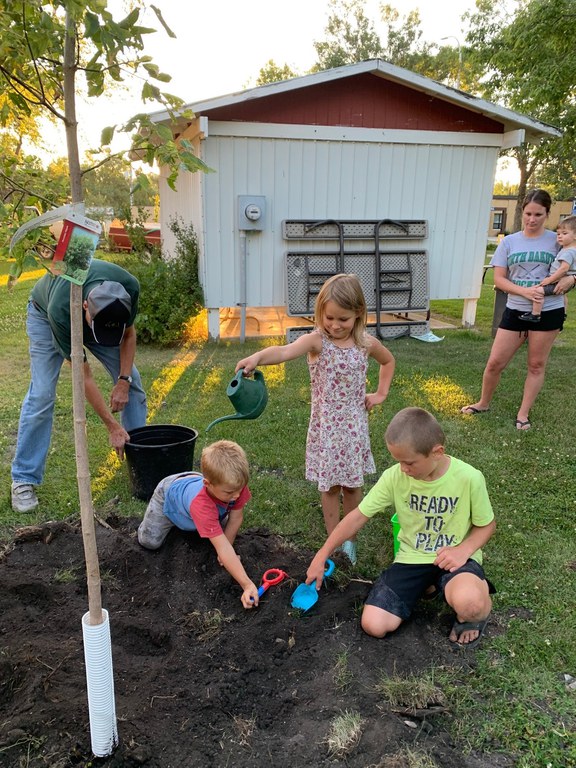
May is Arbor Month in North Dakota. These youngsters enjoyed helping plant trees in McVille during the community’s 2020 Arbor Day.
Gerri Makay
Gerri.Makay@ndsu.edu
Community Forestry Manager
Planting chickpeas and field peas early - implications for disease management
I have been receiving questions about the impact of early planting on agronomic performance of field peas and chickpeas, especially as it relates to disease management.
FIELD PEAS
From 2017 to 2020, the Carrington and Williston Research Extension Centers conducted field studies evaluating the impact of planting date on field pea agronomic performance, with studies conducted in Carrington, Williston, and on-farm locations in Mountrail, McLean and Williams Counties. These studies were conducted to identify strategies to improve management of root rot in field peas, but the lessons learned from these studies are broadly applicable to all field pea production. Two sets of studies were conducted: studies planted to fields with a history of severe root rot in field peas, and studies planted in fields with no history of root rot but inoculated at seeding with the pathogen causing Fusarium root rot.
In fields with a prior history of root rot problems in peas, early planting was associated with sharp reductions in root rot severity. However, early planting was associated with reduced emergence, especially when soil temperatures averaged less than 45°F (at seeding depth, 2 inches deep) in the 7 days after seeding. Yields were maximized when soil temperatures at seeding depth averaged 45 to 50°F in the 7 days after planting.
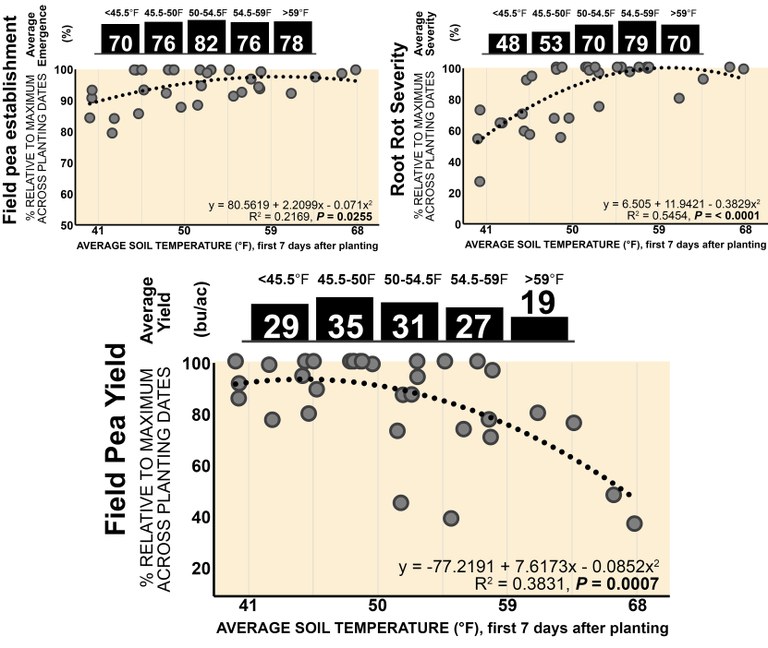
Similar results were observed when peas were grown in fields with no history of root rot in field peas and inoculated with the Fusarium root rot pathogen, except that field pea emergence was higher across all planting dates and no yield penalty was observed in early planting.
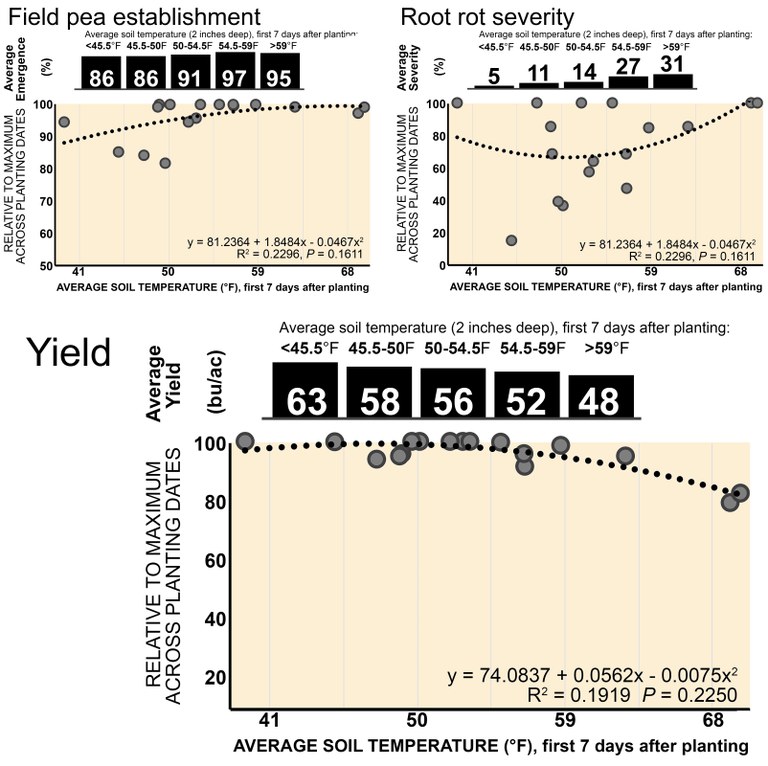
The results indicate that early planting carries the risk of reduced emergence in field peas. In most cases, this reduced emergence is due primarily to seed decay and damping-off caused by Pythium or Rhizoctonia, diseases which are most severe in cool, wet soils. When soils are dry, such as is being experienced across much of North Dakota and northeastern Montana this year, the risk of reduced emergence is lower.
When cool, wet soils are anticipated between planting and emergence, the use of a fungicide seed treatment with activity against Pythium and Rhizoctonia improves field pea emergence. In field trials conducted in fields with a history of root rot in field peas, fungicide seed treatments increased field pea yield by an average 3 to 5 bu/ac when soil temperatures were <55°F (at seeding depth, 2 inches deep) in the 7 days after seeding.
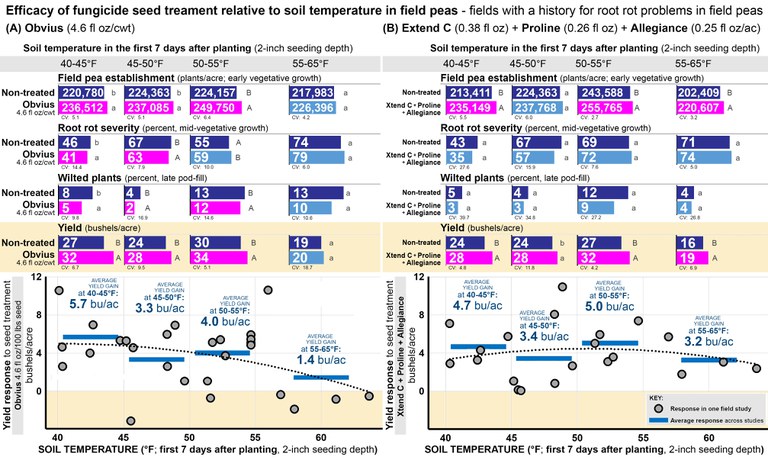
CHICKPEAS
There are strong agronomic advantages to planting chickpeas early - at the same time as planting wheat or very shortly after planting wheat. The Kabuli-type chickpeas with reduced susceptibility to Ascochyta blight that are widely planted in the Northern Plains are late maturing, especially when wet weather occurs in July and August. Early planting facilitates timely crop senescence. When planted at the same time as wheat, the widely planted Kabuli-type varieties 'CDC Frontier', 'CDC Orion' and 'CDC Leader' generally begin senescing in the second half of August even when wet weather extends into July and August. When chickpeas are planted in the second half of May and wet weather occurs mid-summer, these varieties often remain green until the first killing frost.
Early planting of chickpeas has been limited primarily by concerns about soil-borne and foliar diseases. Chickpeas are very susceptible to seed decay and damping-off caused by Pythium and Rhizoctonia, diseases which are most severe when soils are cold and wet. Chickpeas are also very susceptible to the foliar disease Ascochyta blight, and airborne spores released from diseased, overwintered chickpea residues are one of the most important mechanisms of Ascochyta infection. These spores are carried aloft by air currents, travel hundreds of miles in the upper atmosphere, and are deposited during rainfall events. The release of these spores is highest in early spring, and, in the Pacific Northwest, delayed planting has been used to try to reduce Ascochyta infection.
However, with proper attention to disease management, early planting of chickpeas can be very successful in our geography. Soil-borne diseases can be successfully managed with fungicide treatments, and Ascochyta blight can be successfully managed with timely applications of the most effective fungicides.
Fungicide seed treatments with activity against Pythium and Rhizoctonia facilitate excellent chickpea emergence and vigor when cold, wet weather develops after planting.
The following picture illustrates the effectiveness of fungicide seed treatments very clearly. These chickpeas were planted in Carrington on April 22, 2017. Strips of chickpeas were planted to untreated seed or seed treated with Apron Maxx RTA (5 fl oz/cwt). Soil temperatures at seeding depth were above 50°F at planting, but cold, wet weather set in shortly thereafter. Over the next 4 days, 0.53 inches of precipitation fell as a mixture of rain and snow, daytime highs dropped to 33-35°F, and soil temperatures at seeding depth dropped to 36 to 37°F. The chickpeas planted without a seed treatment had very poor stand establishment and never developed a good canopy. The chickpeas planted with the fungicide seed treatment showed good emergence and strong vigor, developed an excellent canopy, and yielded 2,500 lbs/ac.
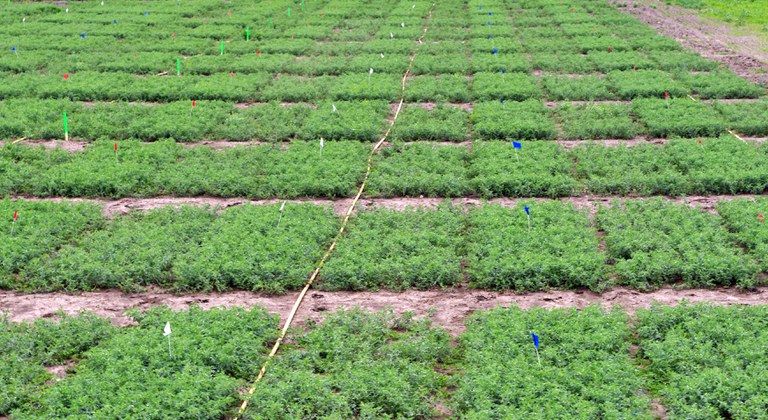
In the Pacific Northwest, chickpeas are commonly planted relatively late in order to reduce exposure from air-borne spores of the Ascochyta pathogen that are produced on overwintered chickpea residues, but the effectiveness of this strategy in the Northern Plains is unclear. In the Northern Plains, spring comes later and mid-summer rains are more common, and significant Ascochyta blight pressure is often observed even when chickpeas are planted late.
When the most effective fungicides are applied when Ascochyta is first developing (one to two lesions per plant on up to approximately 5% of the plants) and follow-up applications are made 10-14 days apart as long as wet weather persists, Ascochyta blight can be managed very successfully. When chickpeas are planted early, senescence is generally observed in mid-August even if rainfall continues through July and August. The earlier senescence conferred by early planting facilitates timely harvest and also reduces late-season disease development on chickpea pods after fungicide applications cease.
In Carrington, we have found that we optimize chickpea agronomic performance with early planting even in wet years. The use of fungicide seed treatments is critical in chickpeas when soils are cool and wet after planting, but the fungicide seed treatments are highly effective even when soils remain cool and wet for an extended period after planting. In dry weather and dry soils, such as that observed across much of North Dakota and northeastern Montana this year, the risk of poor emergence in early-planted chickpeas is greatly reduced, and fungicide seed treatments are less likely to be needed.
Michael Wunsch, Ph.D.
Michael.Wunsch@ndsu.edu
Plant Pathologist
Sunscald in Fruit Trees
We may have appreciated the warm days in March, but in our cold climate, I am afraid we may see sunscald damage this year in trees with thin bark, like fruit, mountain ash and maple trees. The NDAWN data https://ndawn.ndsu.nodak.edu/ shows that in March, we saw 10 days where the temperature swings were 35oF or more with warm days followed by very cold nights. These conditions can lead to sunscald.
Sunscald injures the growth tissue (the cambium) behind the bark of the trunk in winter. You will notice sunscald as an elongated area of dead bark on the south or southwest sides of tree trunks or branches that slope toward the afternoon sun. At first, the area will look sunken with dried, cracked bark. Later, the bark peels off to expose dead wood. Young trees and trees with thin bark, like fruit trees, are more susceptible to sunscald.
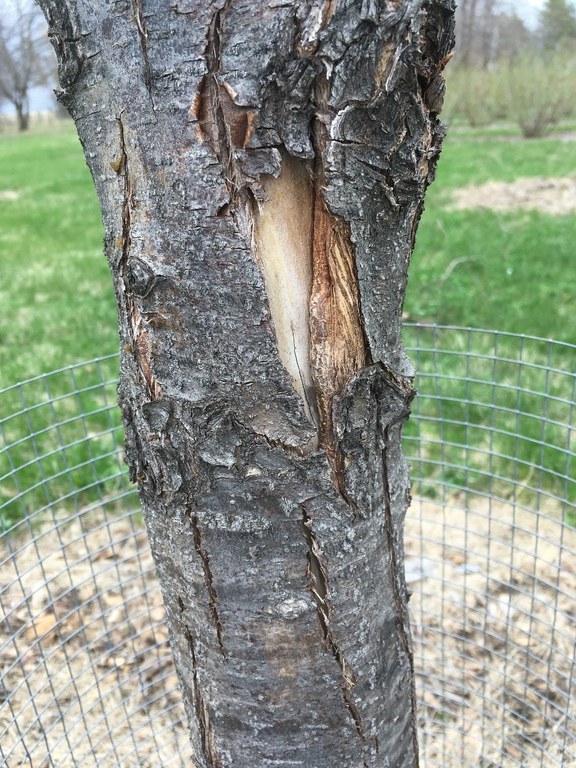
Sunscald injury on Pear – several years old when discovered.
On sunny, cold days, the dark tree bark absorbs the sun’s energy and warms up. This “de-acclimates” the area and it becomes less able to withstand freezing temperatures. At night, the temperatures fall and this area is not able to withstand the effects of freezing. You may not see the damage for several years as it takes time for the bark become dry and then fall away as the healing tissues grow underneath to cover the wound.
If the damage is not too large, a callus will close the wound over several years. But in the meantime, this area is susceptible to fungi and insects. Several years ago, I had to remove a weeping ‘Hazen’ apple tree branch that became infected with black rot after sunscald damage. After you notice the problem, help the area heal by carefully removing dead and loose bark that could be a home for insects or moisture. DO NOT treat the wound with any ‘wound dressing’ or paint. It is best to let it heal naturally.
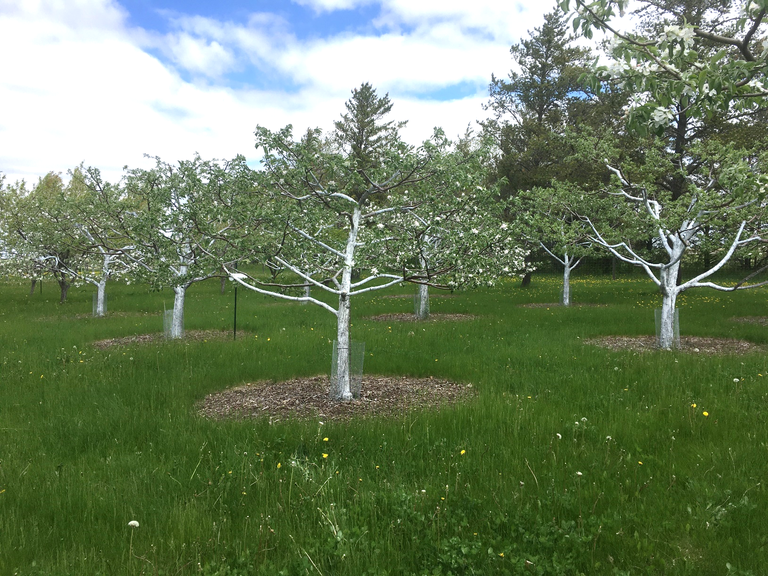 South and SW sides of trunk and larger branches sprayed with 50:50 white latex paint.
South and SW sides of trunk and larger branches sprayed with 50:50 white latex paint.
To prevent sunscald injuries in the future, you need to prevent the bark from heating up.
- Leave lower branches on the south and southwest sides of young tree trunks to provide trunk shade.
- In fall, you can tie a board on the southwest side of the trunk for shade.
- Light-colored, loose tree wraps reflect light and can help. Removed as soon as possible in spring to prevent damp conditions inside the wrap.
- Or, paint exposed trunks and lower limbs on the south and southwest sides with white latex paint to reflect sunlight and keep the bark cool. This is the easiest method and lasts several years but if it is too ugly for you, go with one of the other methods.
FS197E ENVIRONMENTAL INJURY: SUNSCALD AND SUNBURN ON TREES
Washington State University Extension
By Marianne C. Ophardt, WSU Extension Area Horticulture Specialist.
Rita L. Hummel, Ph.D., Horticulture, WSU Puyallup Research and Extension Center
https://bit.ly/3a7TEcM
Kathy Wiederholt
Kathy.Wiederholt@ndsu.edu
Fruit Project Manager
Maximizing Nitrogen Fertilizer Value for Wheat in a Dry Spring
The two principal factors affecting crop yields in the Northern Prairies are soil nitrogen (N) supply and available moisture.
Practices to manage soil moisture and N input and supply will depend on many factors that are unique to the farmer - their soil health practices, crop rotation, productivity of the field, economics, etc.
Continue using the NDSU N calculator for spring wheat (https://www.ndsu.edu/pubweb/soils/wheat/). N use efficiency is reduced with plant stress compared to optimum environments, so N fertilizer rate reduction should be conservative.
A few things to consider for this dry spring:
- Without significant rainfall to alter the current soil moisture deficits that could impact production and yields, farmers should consider strategies that minimize soil moisture loss, such as avoiding cultivating the soil prior to seeding. A low soil disturbance, single-pass seeding is likely to achieve some soil moisture conservation.
- Assuming you know how much available N is in your soil, ensure that adequate N is in the soil by the time the young plant is growing. This will enhance root N uptake, root growth deeper in the soil, and uptake of deeper soil moisture.
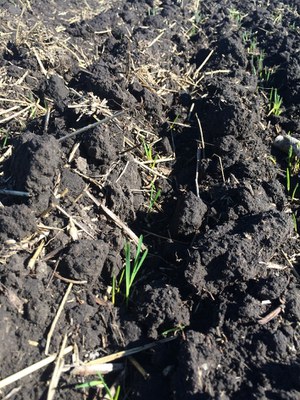
Young plants require adequate N for proper development
- If you must hope for the best and plan for the worse, plan to ensure your crop does not suffer from N deficiency. Lack of moisture combined with N deficiency stress will be too much for the crop. That means, if your N strategy is to be conservative on N input, consider split application by applying at least 65% of the recommended N before seeding and the rest as sidedress or topdress at rates dependent on the soil moisture status and crop outlook.
- Any N topdress comes with the risk of significant N loss, if anticipated rainfall after application is not sufficient to dissolve the fertilizer and carry the N below the soil surface and roots. To avoid this, consider topdress with a N stabilizer fertilizer containing NBPT such as Agrotain* or SuperU* to provide short-term protection from N loss though conversion to ammonia and volatilization.
- Spring wheat variety decisions have likely been made but if the production season results in lower yields due to dry conditions, there should be reduced plant lodging, reduced foliar and head disease, and increased protein among varieties.
- NDSU recommends starter fertilizer for successful wheat production. Dry soils and presence of salts increase risk of reduced plant stands due to seed injury from direct contact of high concentrations of fertilizer. Consider reducing rates of in-furrow placed fertilizer compared to normal soil conditions. See NDSU Extension circular SF712 “Fertilizing Hard Red Spring Wheat and Durum.”
Jasper Teboh, Ph. D.
Jasper.Teboh@ndsu.edu
Soil Scientist
*NDSU does not endorse commercial products or companies even though reference may be made to tradenames, trademarks or service names.
Maximizing Soybean Yield Potential in Dry Conditions
There’s no single strategy to deal with drought conditions, but there are strategies that farmers should consider to maximize their soybean yield potential.
With limited soil moisture available, maintain topsoil moisture currently present. That approach begins by limiting or eliminating preplant tillage. Soil moisture is lost with every tillage pass. We likely will need this moisture during the last-half of summer when seed is being produced. Plus, research shows that soybeans respond to direct seeding into previous crop residue or no-till. Across 37 NDSU tillage trials, conservation tillage (direct seeded, strip till or no-till) averaged 4 percent greater soybean yield compared to yield with conventional tillage.
Another factor that can boost soybean yield potential is to start planting early. Soybean seeding shouldn’t take priority over cool-season crops like wheat in the ground, but farmers should take advantage of the earliest possible planting windows. NDSU encourages early planting as long at the seeding dates follow crop insurance guidelines and if the soil is fit.
Early planting gives growers a number of advantages. There’s a better chance of topsoil moisture being present in early May, versus the last half of May. Plus, early planting will increase yield potential. NDSU data averaged over nine trials shows 8 percent yield increase when planting the first 10 days of May versus waiting until the last half of May. Early planting also gives growers the opportunity to plant a full season variety, which offer better yield potential. Based on an extensive commercial field survey (over 1000 fields) by NDSU across North Dakota, for every 0.1 increase in maturity group, there is about a three-quarters of a bushel per acre yield increase. For example, going from a 0.2 to a 0.6 maturity, may translate into an increase of about three bushels per acre.
NDSU recommends planting soybean in rows as narrow as possible. Plus, farmers should strive for early season stands of 145,000 to 155,000 established plant per acre in eastern North Dakota.
We want the crop canopy closed as soon as possible. This provides a good environment to conserve moisture if we continue to have dry weather by preventing moisture loss from evaporation. Also, canopy closure increases yield potential by capturing sunlight sooner and helping soybean be more competitive with weeds.
With the topsoil dry, some farmers may be tempted to plant soybeans deeper than normal (ideal depth is 1- to 1.5 inches) to access soil moisture. Place the seed at the soil moisture level but do not exceed a 2-inch depth. Planting larger, high quality soybean seed can be useful in maximizing yield potential, especially when planting deep. The larger seeds have more energy, which gives the soybean shoot a greater chance of emerging into a viable plant.
In summary, the best approach begins with timely planting and managing for maximum yields. Our general recommendations will not change because of the threat of dry weather. If we plan for a drought, then we limit ourselves in yield potential.
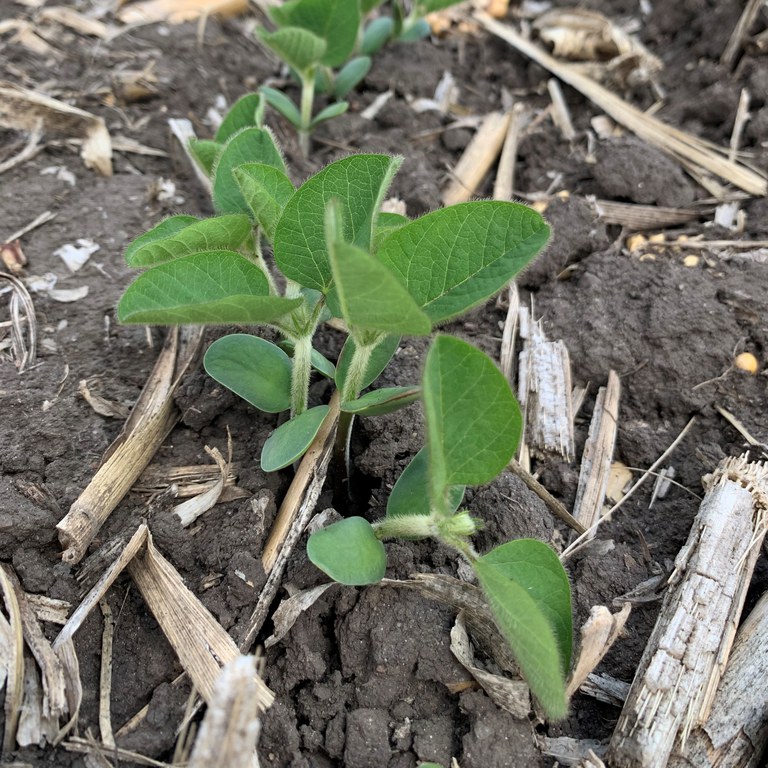 Soybean producers should strive for timely planning and manage fields for maximum yield.
Soybean producers should strive for timely planning and manage fields for maximum yield.
Greg Endres
Gregory.Endres@ndsu.edu
Extension Agronomist
Noxious, Troublesome Weeds Spread Through Manure
Using manure as fertilizer can lead to the spread of noxious and troublesome weeds. (Gasp!) Yes, the person who sings its praises from the top of the piles is ready to talk about it. It is a known fact that weed seeds pass unharmed through the digestive tracts of ruminant animals (cattle, sheep). This means that whatever weed seeds are in the feed or bedding you’re using are still viable when they exit the animal as manure. There is also a line of thought that says there is an extensive weed seed bank in most fields already and applying manure gives them the nutrients they need to grow. Either way, manure does promote plant growth.
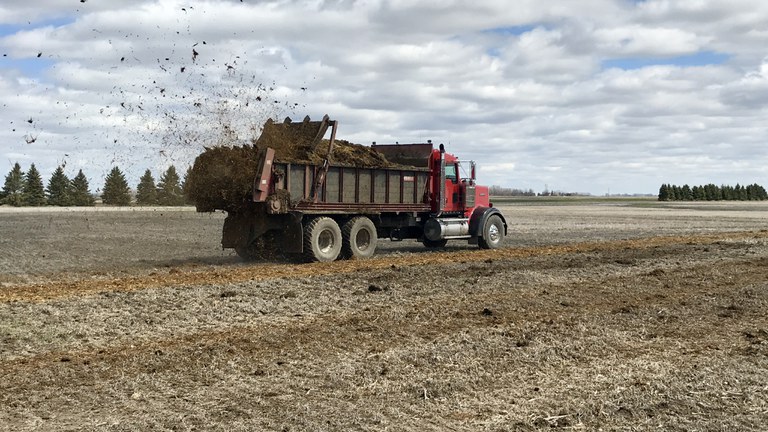 Spreading manure on harvested fields at the NDSU Carrington REC
Spreading manure on harvested fields at the NDSU Carrington REC
Producers have tools to minimize the amount of viable weed seeds in fresh manure, one of which is composting. Information about composting is available in a self-paced online workshop at https://tinyurl.com/2020CompostingWorkshop. To learn the reasons behind these composting operations, check out https://tinyurl.com/2020CompostProducerOperations.
Another tool more commonly used is herbicide control. Applying a pre-emergence herbicide will help reduce competition between weeds and newly seeded crops. But what happens when those herbicides don’t work on specific noxious and troublesome weeds? How do you keep noxious and troublesome weeds at bay when you need to spread manure but know hard-to-control seeds such as Palmer amaranth and waterhemp are present? Even in direct competition with a crop, these plants can still produce up to 100,000 seeds in a year.
Due to this extensive seed production, the ability of the weeds to germinate throughout the growing season, and widespread resistance to glyphosate and Group 2 herbicides, herbicide programs for control of severe infestations of waterhemp and Palmer amaranth often will cost two to three times the amount of money spent on a weed control program in fields without these two weeds.
In addition to the added cost of controlling these weeds, weed scientists in the U.S. have documented herbicide resistance in Palmer amaranth to every herbicide mode of action that can be used in row crop production.
This is why it is important to scout fields for these two pigweeds before they become established. In many cases where the weeds are spread in contaminated manure, the infestation starts with a manageable level of plants and the population can be managed by hand pulling if correctly identified.
Producers have a few steps they can take to help mitigate and monitor the potential impacts of these weeds.
- Keep records of where they spread manure so they can monitor that field throughout the growing season.
- Clean spreading equipment before moving to a new field. This is probably one of the most important and least popular steps you can take. If you are doing custom work for someone, this is especially important as you do not want to take one client’s issue to the next client. Clean the spreader with an air hose for dry manure or a pressure washer for wet manure. This takes time and can be messy but can save years of headaches down the road. Make sure to record where cleanout occurs so you can monitor that spot during the growing season.
- Spread weed seed-heavy manure on tame grass pastures or grass hayfields because more options are available for herbicide control on them. It is never recommended to spread manure on native rangeland. Adding additional nutrients can benefit invasive grass species such as Kentucky bluegrass and smooth brome.
For more information about noxious and troublesome weeds or manure management contact your local NDSU Extension agent.
Thank you to my co-authors Miranda Meehan and Joe Ikley.
Mary Keena
Mary.Keena@ndsu.edu
Extension Specialist/ Livestock Environmental Management
Planning for Estrous Synchronization
Artificial insemination (AI) is great technique to incorporate superior genetics into a cow herd. High accuracy genetics are available from multiple bull semen companies. One of the most popular uses of artificial insemination and estrous synchronization is in breeding heifers to high growth calving ease bulls.
The Beef Reproduction Task Force is comprised of reproductive physiologists from across the United States. In addition to education, the task force publishes estrous synchronization protocols for both beef cows and beef heifers.
The beef cow protocols are arranged in three categories: Heat Detection, Heat Detect & Time AI, and Fixed-Time AI. (Bos Indicus cows have a separate protocol.) Protocols run from 8 to 13 days, with drugs administered at prescribed times.
These protocols can be found online at Beef Reproduction Task Force (http://beefrepro.org). Click on ‘Protocols’ and select either ‘Conventional semen’ or ‘Sexed semen’ for the appropriate protocols.
All protocols use various combinations of GnRH (gonadotropin releasing hormone), prostaglandin (PGF2 alpha) and CIDRs. CIDRs contain a progesterone hormone to delay cows from coming into heat. GnRH stimulates ovulation and prostaglandin regresses the corpus luteum which leads to cows coming into heat.
For beef cows, the 7-day CO-Synch + CIDR is popular for timed AI breeding. On Day 1, GnRH is injected and a CIDR is inserted within the cow’s vagina. On Day 7, the CIDR is removed and prostaglandin is injected. Between 60 and 66 hours after CIDR removal, GnRH is again injected and the cow is inseminated. Successful pregnancy rates with Timed AI are between 50- 65%. Higher conception rates involve strict adherence to protocols, cows in good body condition and health, and excellent AI technique.
Beef heifers have similar synchronization options with an additional drug option of using MGA in place of the CIDR. MGA is fed daily and feed intake must be even across all heifers. A popular synchronization protocol is the long-term timed protocol using MGA and prostaglandin. In this protocol, MGA is fed for 14 days. At 19 days after the last MGA feeding, the heifers are injected with prostaglandin and then 66 hours later the heifers are injected with GnRH and inseminated. This long-term protocol takes 33 days from start to AI.
A short-term protocol for heifers is the 7-day CO-Synch + CIDR. From start to AI, this short-term protocol takes 9 days and requires moving cattle through a chute on Days 0, 7 and 9 for a total of three visits to the chute.
Visit with your AI technician and your bull semen salesperson. They can provide insight into techniques that work for them in obtaining high conception rates with Timed AI.
Karl Hoppe
Karl.Hoppe@ndsu.edu
Extension Livestock Systems Specialist
Intercropping Wheat and Flax in an Organic Production System
Intercropping is the practice of growing two or more crops together at the same time in the same field. The idea is to find combinations of plants that complement each other or perform better together than when planted alone.
Intercropping may have positive or negative effects on yield and quality compared to mono-cropping. Organic flax yields are generally low, mainly due to weeds, as flax is a poor competitor. Intercropping wheat and flax in an organic system can aid in suppressing weed competition by providing greater plant density. Important considerations for intercropping include: proper seeding rate/plant density for each component of the mix, and variety selection to match maturity dates.
A field trial to examine organic intercropping of wheat and flax was conducted this past year at the CREC. The trial was featured at the CREC virtual field day and can be viewed at this link. https://www.youtube.com/watch?v=IATO9z8Dj3k
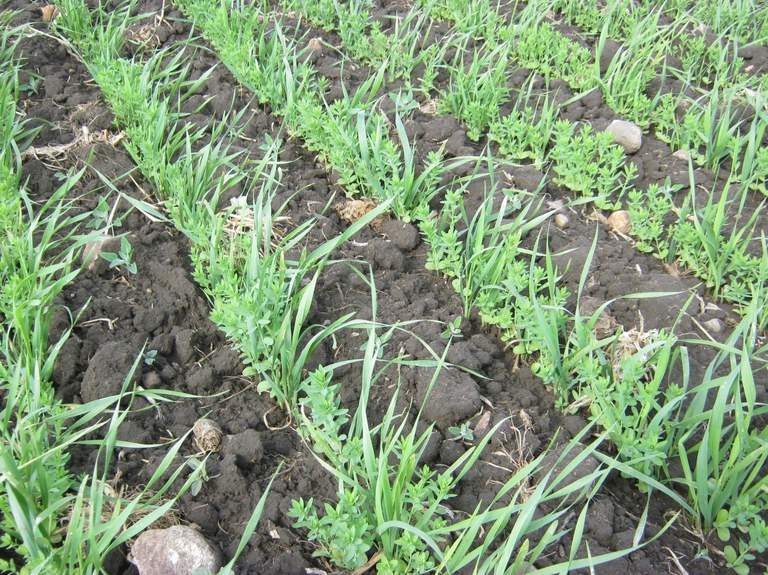 Wheat flax intercrop on June 8, 2020.
Wheat flax intercrop on June 8, 2020.
The sole seeding rates used in the trial were 1.6 million seeds/ac wheat and 55 lbs. PLS/ac flax. The intercrop treatments were planted at 2/3 the sole rate or 1 million seeds/ac wheat and 37 lbs. PLS/ac flax. Two varieties of wheat, FBD Dylan and Glenn, and two varieties of flax, Omega and ND Hammond, were used. The trial was sown May 18 on ground that was previously a cover crop of rye, crimson clover, lentils, and turnips. Wheat and flax were sown in the same row together with a row spacing of 7”. Stand counts were taken on June 2 to determine plant densities of rates used. The trial was swathed on August 13 and harvested on August 20.
Performance of each crop component are presented in tables 1 & 2. Yield levels for both wheat and flax were low due to the warm dry conditions experienced this past growing season. The stress the trial had is demonstrated by the early heading/bloom dates along with short plant heights.
Intercropped wheat yields were 50-62 % of the check or sole wheat. Intercropped flax yields were 68-75% of the check or sole flax. Wheat quality was lower when grown as an intercrop. Test weights of wheat were decreased by as much 2 lbs/bu with grain protein seeing a similar trend of lower protein when grown with flax.
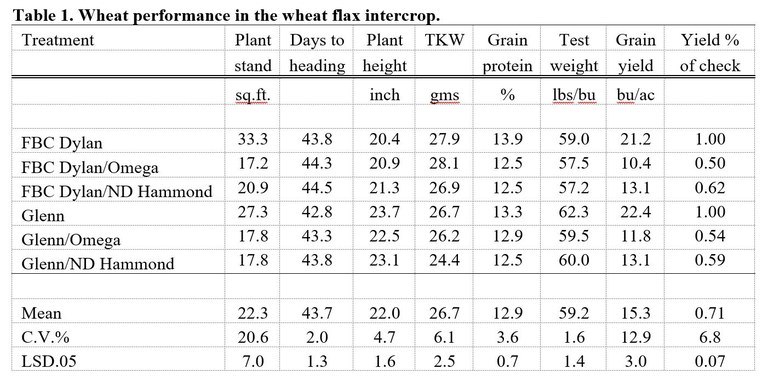
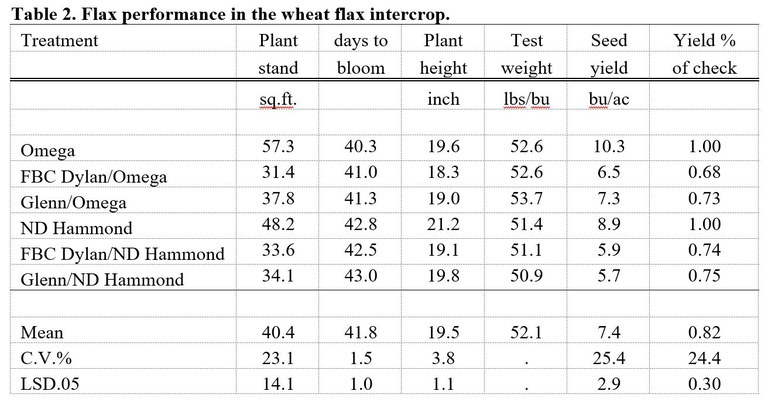
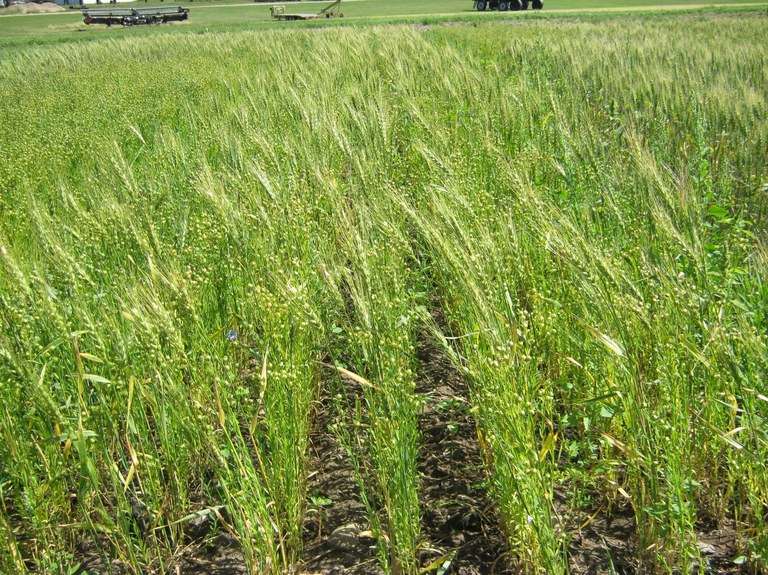 Wheat flax intercrop on July 22, 2020.
Wheat flax intercrop on July 22, 2020.
Crop component yields and Land Equivalent Ratio are presented in table 3. Land Equivalent Ratio (LER) is a measure of the amount of land it would take to achieve equal yields of the intercrop as compared to growing the crops sole. If the LER is greater than 1.0, overyielding occurred and the intercrop is more productive then growing either of the crops alone. LER for all intercrop treatments ranged from 1.17 to 1.36, meaning it would take 17 to 36% more land to equal the intercrop yield if each crop was grown alone. Results gathered also demonstrate that when ND Hammond flax was used in the intercrop over yielding was greater than the Omega intercrop.
Steve Zwinger
Steve.Zwinger@ndsu.edu
Agronomy Research Specialist
Spreading Manure Across the Frozen Plains
A question usually come up every year around late February or early March, especially if it’s an “in like a lamb” situation like we’re having this year. It usually comes as people are getting antsy indoors and start to venture out on little trips across the state. The question is something along the lines of, “Can/should people be spreading manure right now?”
The short answer: yes-ish.
The long answer is…In North Dakota, manure can be applied to frozen ground where runoff is contained and does not drain off during spring runoff. Land with less than 6% slope, with stubble or vegetative cover and less than 8 inches of snow should be considered.
Solid beef manure contains the primary macronutrients nitrogen, phosphorus and potassium, as well as secondary macronutrients and several micronutrients. Manure nutrient content can be impacted by several variables, such as North Dakota’s dynamic climate and available feedstuffs for cattle (Lardy et al., 2015). Animal diet and maturity also can impact the nutrient content of manure. As an animal grows to maturity, protein requirements decrease and carbohydrate forms change, thereby decreasing the concentration of these nutrients excreted as a percent of body weight. Similarly, increased levels of minerals fed to livestock (e.g. copper, phosphorus, sodium) increase the levels of those nutrients in the manure (Midwest Plan Service, 2004).
A project was created to test and identify what nutrients are specifically available in North Dakota’s beef manure. From 2011 to 2013, 192 solid beef manure samples were collected across North Dakota and analyzed for nutrient content. You will find the results of that study in the brand new publication titled “Nutrient Characteristics of Solid Beef Manure in North Dakota.”
While averages are convenient to have for planning purposes, actual values can vary widely. Therefore, analyzing your livestock manure for nutrient content is the best way to know the actual values to help make application as accurate as possible. To answer all of your manure sampling questions, the “Solid Manure Sampling for Nutrient Management Planning” publication has been updated to include simple steps as well as sections on how to read and use the manure analyses results. Manure testing should be paired with a soil test. Your NDSU Extension agent can help you find a laboratory that can analyze your manure and soil samples.
If you don’t have the equipment to spread manure you can always contact a North Dakota Custom Manure Hauler.
Mary Keena
Mary.Keena@ndsu.edu
Extension Livestock Environmental Management Specialist


